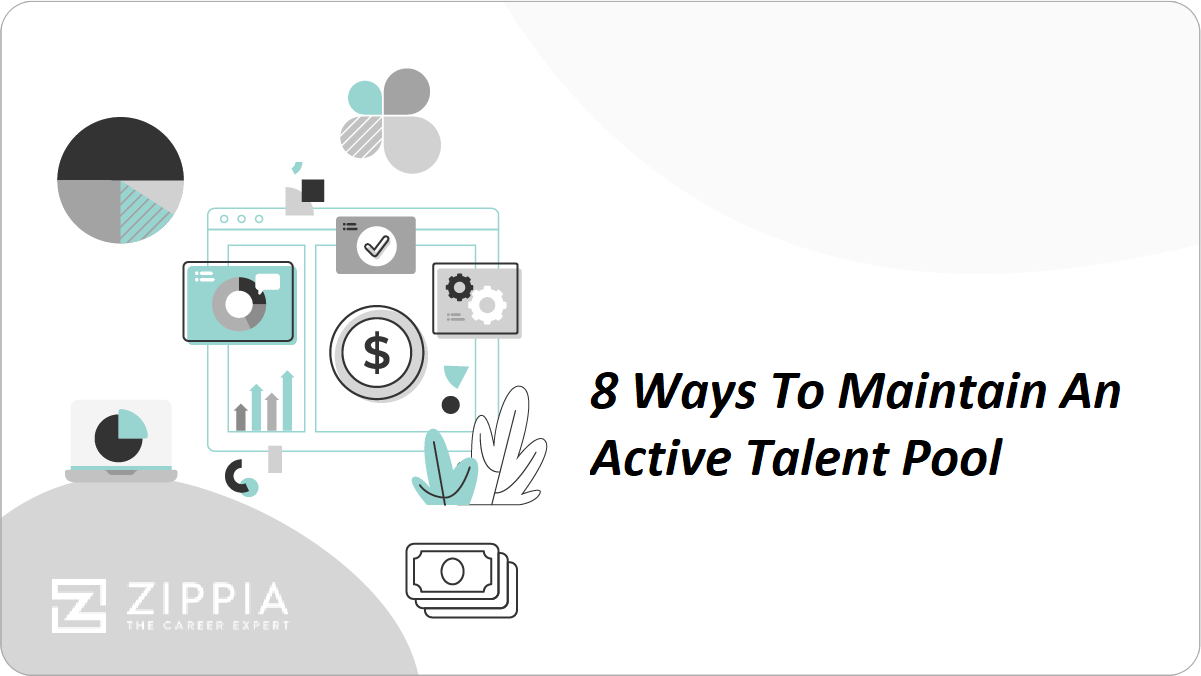Many recruiters find themselves being reactive rather than proactive. They react because they do not have an active talent pool and they think they can change what happened but this is not so. Only those who take the proactive approach, which mainly involves acting before a situation becomes a crisis, manage to stay ahead in their respective industries.
A talent pool can be described as a small group of people in whom recruiters look for potential candidates who are suited for the employer’s current needs. Creating an effective talent pool ensures that there is a constant flow of the best candidates available in the job market. A talent pool needs to be dynamic for it to be effective.
Key Takeaways:
-
Having an active talent pool means you have qualified candidates at hand and it helps minimize recruitment costs.
-
Look at present candidates as well as previous candidates to help keep your talent pool active and engaged.
-
Consider looking at college students or recent college graduates and offer internships or shadowing programs to help get them interested in your company.
-
Using a platform and social media helps you connect and build a community for the organizations future talent needs.

What is a Talent Pool?
A talent pool is a group of potential candidates who have an interest in working or your company or organization. The pool may look different depending on the needs of your company or organization and it can include both passive and active job seekers, and internal and external employees. All the candidates within the talent pool can be a mix of candidates that applied before and weren’t the right fit at the time or people with specific expertise.
Building your talent pool and maintaining the candidates in it will help decrease the time it takes to hire people. When you have a solid start point to begin your search, your efforts with the recruitment campaign will decrease.
Benefits of a Talent Pool
Benefits of a talent pool include:
-
Always having qualified candidates at hand. When a talent pool is build and maintained right, you should always have a great source for qualified candidates. This is also great because even if a previous candidate was not right for a certain position, a new one might open up that they are right for.
-
Having a long term recruiting strategy. Having a long term recruitment strategy is a great way hire employees fast. Having and maintaining a talent pool helps you get an idea bout positions and profiles you have covered, and ones that need help with.
-
Having passive candidates give their details and contact information. Passive candidates can sometimes be difficult to get. These candidates are typically happy with their current job and are not actively looking for new opportunities. With the rise of social media, it has become easer to connect with them and get their contact information.
-
Minimizes recruitment costs. When you have a diverse talent pool, it eliminates needing to launch a big recruitment process every time you need to hire. Over time and as your talent pool grows, you are connecting and networking with new people, making it easier to find candidates or get referrals.
8 Ways to Maintain an Active Talent Pool
-
Analyze talent through a process. Today, recruiters always have thousands of applicants who are ready and always willing to fill a vacancy in any particular organization at any specific time. But when you think about it, there is still a lack of collaboration between the right opportunity and the right candidate. And that is why having active talent pools in place is essential in creating and maintaining stability in business.
This process is unique for every organization, but the goal is the same for all organizations.
The goal is to create strategic plans for future demand and supply of talent. Talent forecasting involves more than a headcount analysis. Always assess your expertise through a well-designed process according to the size of your business and your industry. Having an efficient method in place will not only create an active talent pool, but it will also maintain it over a long period so long as it is followed religiously.
-
Your current activities should foster the efforts of your talent pool in the future. The foundation of building an active talent pool for recruitment is that the recruiting process happening now should strongly affect the future of your organization. Organizations should find out what necessary skills, educational background, and experience are needed. The HR department should not rely on or use old job descriptions since the business world is evolving at a rapid rate. And only those who are creative will survive and thrive in the future. Develop new job descriptions after discovering the organization’s current and future needs.
It is important for your talent pool to know your future needs, maybe five to ten years to come; not the requirements you had five or ten years ago when you created your job descriptions. By innovating and implementing new recruitment and hiring practices, you keep yourself ahead of your competitors.
-
Communicate with former applicants. Your recruiters should not dismiss previous candidates who showed a keen interest in being part of the company by applying and going through the entire interview process. Your recruiters should provide a desirable and memorable experience to the applicants who go through the interview process but might not get hired.
Communicating with these potential candidates and telling them why they did not get the chance to be a part of the organization is essential so that when a need for them arises again in the future, they will have a constructive view which will help improve their employability with the organization. Such candidates should be included in the talent pool because recruiters previously considered them and they have a potential of being a better fit in future.
For every job opening, an organization typically receives approximately two hundred and fifty resumes. Professional recruiters and hiring managers should take their time and consider those two hundred and forty-nine who were not successful to join the organization by searching for appropriate skills and suitability for other positions in the organization.
-
Look at your present candidates Since it is critical to look at your former applicants so that you can potentially fit them in the organization in the future, how important is it to analyze your current candidates?
When recruiters do talent forecasting, they are creating opportunities for future candidates. This active pool has shown interest in being a part of your organization. And they have dedicated their resources to enable the entire hiring process work.
Anyone who shows interest in being a part of an organization should be included as a prime member for your talent pool. This provides job seekers and existing employees searching for internal opportunities to grow their careers.
-
Build talent pools internally. Most of the time, interviewing and recruiting gets tougher, challenging and more expensive the higher the position is within the organization. Internal talent pools save a lot of resources which interviewing and recruiting can cost the company.
Research conducted by professional hirers reported that external hires had a sixty-one percent more likelihood of being fired from an organization compared to an internal candidate. Internal candidates understand and are part of the company culture hence having a lower risk of being fired. The most successful talent managers understand the importance of creating highly skilled talent pools internally.
Generating a talent pool inside the organization is an essential element of talent management. A consistent and reliable internal pool will help in developing desirable skill sets resulting in improved performances across all functions and levels and paves a way to an easier succession planning process.
-
Use a platform. An organizations’ career page is a good platform to build a community for the organization’s future talent needs. Recruiters need to invite and communicate with current and retired employees, recruiters, job candidates, and human resources professionals. Recruiters can use social media platforms such as Facebook or LinkedIn or recruitment software for an internal network.
These people understand the culture, and they have invested a lot of time and money towards the success of your organization. Encourage them to share their information and communicate about their experience in the organization with those who are interested and have the potential of being employed by the organization in the future.
You should create an exclusive environment for the participating members to feel secure when they share information. Sending newsletters, blog posts, videos and webinars regularly will enable members to share their personal opinions on a wide range of topics and even come up with original quotes. Connect your community in social media too to keep them engaged.
-
Engage with students and graduates-to-be. Since talent pooling is about planning ahead, there’s no better place to start looking that with students. Start looking at college seniors and offer internships or shadowing programs. They are still trying to figure out where they want to go, so it gives them an opportunity to learn about the company and position more.
Social media is a great way to show students and recent graduates what it’s like working for your company and what they can expect if the decide to look into it more. Offering a internship program or shadowing program is also a great way to spot talent and see who will be a good fit for the company later on.
-
Understand the importance of a diverse talent pool. Unconscious bias is the reason for may candidates from being looked over for other candidates, making your company lose out on skilled candidates. Make sure you regularly take a look at your recruitment process and evaluation guidelines for your talent pool.
Having diverse candidates and a diverse talent pool helps you bring in new ideas for the company and stay successful.
Final Thoughts
You need to take a proactive approach towards building your talent pool rather than a reactive approach. By implementing the six methods outlined above, you shall create an active talent pool for the organization before it becomes a crisis. Be proactive! Think about the future employees of your organization.
- Recruitment Strategies
- Talent Acquisition
- Recruiting Methods
- Social Media Recruitment Strategy
- Making a Recruitment Video
- Sourcing Talent
- Social Media Recruitment Strategy
- Talent Attraction Strategies
- Recruitment and Selection Policy
- Recruitment Goals and Objectives
- Linkedin Recruitment Tips
- Career Fair Checklist
- How To Add Value As An In-house Recruiter
- Linkedin Recruiting Secrets
- The Myth Of Guaranteed Placement
- How To Source Multi-generational Talent
- The Recipe For Great Recruitment
- Why Sourcing Isn't Recruiting
- How To Build A Talent Pipeline On Linkedin
- The Modern Recruiting Workflow
- How To Wite Cold Emails To Passive Candidates
- Essential Recruiting Metrics
- How To Recruit Talent At A Conference
- Cold Recruiting Emails To Candidates
- How To Maintain An Active Talent Pool
- How To Write LinkedIn Messages To Candidates
- Recruiting Metrics That Matter
- How Blind Hiring Can Contribute Workplace Diversity
- Why Internal Recruitment Is The Best Place To Start
- Recruiting Alternatives Linkedin
- How To Create A Recruitment Plan





